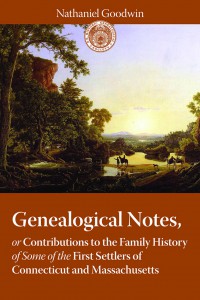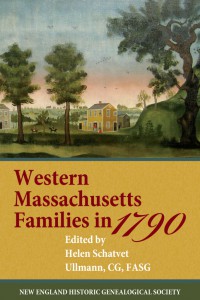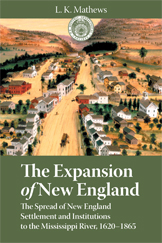 As the first settlements in seventeenth-century Massachusetts colonies became more established, and as various reasons for becoming restless or disenchanted within them developed, people began their forays beyond the known. In Genealogical Notes: First Settlers of Connecticut and Massachusetts, Nathaniel Goodwin covers families in such Massachusetts towns as Cambridge, Concord, Lynn, and Northampton and such early Connecticut towns as Windsor, Wethersfield, Simsbury, and Hartford. This book is a great resource for “those interested in first generation Connecticut and Massachusetts families,” says NEHGS President and CEO D. Brenton Simons. Goodwin included more than forty seventeenth-century families in this book of compiled notes, helping to build the foundation on which, according to Simons, “countless genealogists” have expanded.
As the first settlements in seventeenth-century Massachusetts colonies became more established, and as various reasons for becoming restless or disenchanted within them developed, people began their forays beyond the known. In Genealogical Notes: First Settlers of Connecticut and Massachusetts, Nathaniel Goodwin covers families in such Massachusetts towns as Cambridge, Concord, Lynn, and Northampton and such early Connecticut towns as Windsor, Wethersfield, Simsbury, and Hartford. This book is a great resource for “those interested in first generation Connecticut and Massachusetts families,” says NEHGS President and CEO D. Brenton Simons. Goodwin included more than forty seventeenth-century families in this book of compiled notes, helping to build the foundation on which, according to Simons, “countless genealogists” have expanded.
 First Settlers and other titles we’ve discussed previously have facilitated research on early Eastern Massachusetts colonial families, but tracking the children of those families can be another story. Here’s where Western Massachusetts Families in 1790 can help. According to the book’s editor, Helen Schatvet Ullmann, “the sons and daughters of those families who moved west were often lost to genealogists.” Because the first stop on this westward path was often Western Massachusetts, examining this region through the 1790 U.S. Census – the first one conducted for the states then in the Union – helps address the genealogical challenges of researching transient families of the era. This book is useful not only to researchers whose ancestors are covered within the sketches of fifty families but also to those whose ancestors are known to have lived in those western towns – clues may be unearthed by looking at the sketches of other families from those towns.
First Settlers and other titles we’ve discussed previously have facilitated research on early Eastern Massachusetts colonial families, but tracking the children of those families can be another story. Here’s where Western Massachusetts Families in 1790 can help. According to the book’s editor, Helen Schatvet Ullmann, “the sons and daughters of those families who moved west were often lost to genealogists.” Because the first stop on this westward path was often Western Massachusetts, examining this region through the 1790 U.S. Census – the first one conducted for the states then in the Union – helps address the genealogical challenges of researching transient families of the era. This book is useful not only to researchers whose ancestors are covered within the sketches of fifty families but also to those whose ancestors are known to have lived in those western towns – clues may be unearthed by looking at the sketches of other families from those towns.
 As a complement to these genealogical sketches, Lois Kimball Matthews’s Expansion of New England: The Spread of New England Settlement and Institutions to the Mississippi River, 1620–1865 provides readers with the where and why people migrated. The book presents nearly 30 maps that put a lens on the larger migration patterns in the seventeenth and eighteenth centuries as people first settled east of the Mississippi; then traveled out to Ohio, Illinois, Indiana, Michigan, and Wisconsin; and eventually headed to the Old Northwest Territory. NEHGS Executive Director Emeritus Ralph J. Crandall notes that book “helps the genealogist by examining in detail virtually all printed town histories and other works extant in 1909 that note specific migrations,” which are usually small clusters of families. The book addresses the ongoing migration in terms of the socio-economic and religious reasons behind it as well as its effect on the settlers’ relationship with Native Americans.
As a complement to these genealogical sketches, Lois Kimball Matthews’s Expansion of New England: The Spread of New England Settlement and Institutions to the Mississippi River, 1620–1865 provides readers with the where and why people migrated. The book presents nearly 30 maps that put a lens on the larger migration patterns in the seventeenth and eighteenth centuries as people first settled east of the Mississippi; then traveled out to Ohio, Illinois, Indiana, Michigan, and Wisconsin; and eventually headed to the Old Northwest Territory. NEHGS Executive Director Emeritus Ralph J. Crandall notes that book “helps the genealogist by examining in detail virtually all printed town histories and other works extant in 1909 that note specific migrations,” which are usually small clusters of families. The book addresses the ongoing migration in terms of the socio-economic and religious reasons behind it as well as its effect on the settlers’ relationship with Native Americans.
Leonard Burke and Mercy Bigelow Wight moved from Springfield, Mass to Kewanee, near Wethersfield, Ilinois in 1856. Farmland was sold in Springfield and purchased in Kewanee. I would like to understand why they moved. Was it with a Congregational church or what? Any thought, or places to look?
Ted Wight
In the “new places”, land was usually reasonably cheap and you had a lot of “elbow room”. Plus, frequently at home, the family homestead went to another sibling, so you had to go somewhere to start your own homestead.
In all due respects since I have never seen a Church steeple in the West with a
rooster or fish on top— such families probably moved to GET AWAY from the extreme constraints placed on them by the Congregational Church— a New England based Theological Oligarchy that controlled everything from emotions to dress !
Viola, that is an interesting slant on things. But why did they move to Congregational “towns” such as Wethersfield and Kewanee?
To cite http://www.kewanee-il.com/history.php, “In the fall of 1835, Caleb Tenney of Wethersfield, Conn., wanted to found a colony in Henry County .The Connecticut Association was formed and a committee was sent west
early in 1836 to select and buy land.” Talking points -1) by that time, an awakening of the New England conscience had occurred….. hence any Congregational Parish at that time would have mellowed ( aka….a view of the photo gallery of Kewanee shows one church, typical of the New England style but with a Cross on the Steeple !) and 2) by that time, ref. ditto. …”.the Indians had been pushed across the Mississippi, opening one of the last regions of Illinois to white settlement.” Hence being thrifty “Nutmegers” — it can be assumed that it was an opportunity that they could not refuse !
Just a minor note: Ohio, Indiana, Illinois, Michigan, and Wisconsin (and part of Minnesota) actually were the old Northwest Territory.
My interest is more in those who moved north. In 1760 about 50 Cape Cod families, about 2000 people in 22 ships, moved to and settled Liverpool, Nova Scotia. They included Elisha Freeman, my 5th ggfather, and his 10 adult children and their families. I assume the major reason was economic as opposed to political. There is a fair amount written about this group and their progress in Nova Scotia, but little if anything about who they were and why they left. Any suggestions as to sources and resources would be welcomed.
Jack Freeman
You may wish to read, ” A Great and Noble Scheme” by Jack Mack Faragher (Norton: 2005). His account of the Acadia removal in Nova Scotia and their replacement by such migration groups as yours is detailed.
Faragher’s , Chapter 15: ” The Rays of the Morning. End of the Removal Era, 1760-1785″, details such New England migration flotilla’s…. the motivation and opportunities of such settlement.
Thank you. The book is at my local library so I have put a hold on it.
Jack
Elisha, my group of Cape Codders moved from the Truro, Eastham, Wellfleet area to Maine about 1745. From what part of the Cape did yours depart? Also, which Freeman line did your Elisha descend from? If you answer these, I can tell you where I have found some source work.
Thank you for your response. Elisha Freeman was a greatgrandson of Samuel Freeman who arrived from London in 1630, settled in Watertown (Boston). Samuel’s son, also a Samuel, whose mother Apphia married Thomas Prence, moved to Eastham in about 1650. Samuel the 3rd was born in Eastham in 1662 and died their in 1742. Elisha was born in Eastham in 1701. His first wife Lydia who was the mother of their 10 children, was also a Freeman, the greatgranddaughter of Edmond Freeman who arrived from Sussex in 1635 and was one of the first settlers of Sandwich. The 2 Freeman branches were not related until Elisha and Lydia married. I’d be pleased to hear about the source work you refer to.
Jack
An ancestor, a descendant of the Jewett family who were among the founders of Rowley, MA in 1639, moved to Hollis, Hillsborough Co. New Hampshire after he saw the town during the Rev. War and liked it, according to an old history of the county. One of his sons married in Hollis, had a couple of children there, then moved to Cleveland, Cuyahoga County, OH. I’ve never figured out why. Most of their children stayed in the area, but my gg grandmother married a Methodist Episcopal preacher, who himself was born in Schenectady, New York to a Dutch Reform family. I don’t know how or why this family went west either! This Methodist couple spent most of their lives in IL. In the next generation, my g grandparents and their children moved to eastern WA, because of letters from a relative who’d already made the move. My grandparents and their children moved to the WA coast, living for a while in a tent on the beach. Coast to coast in five generations, for reasons I can’t always reconstruct. Transportation used probably ranged from walking and horseback to barge on the Erie Canal and/or Ohio River to train from IL west, to car to donkey on the trail to the beach on the Pacific Ocean in 1925. The subject of migration has always fascinated me. I’ve just received “The Expansion of New England,” and can’t wait to dig into it.
Another good resource: Migration from Vermont by Lewis Stillwell.
The 1790 census is not complete for Massachusetts as the town of Monson is missing. I have looked at the church’s records so know my ancestors lived there but the 1790 census includes none of them. At first I thought I could find them in Brimfield but they’re not there either. No one that I have contacted has ever admitted that the whole town is missing.
Of the hundreds of my paternal ancestors in numerous lines that I’ve found, it amazes me that only my grandfather, George Prichard, and his wife, my grandmother Jane Bigelow, lived their entire lives (other than military service) in one place: Monona County, Iowa. For 10 to 12 generations in the new world before them, very few of their direct ancestors died in the same place they were born. Most of these lines stretch back to earliest New England, with one line back to Colonial New Jersey and another to Colonial Virginia.
So I have followed the descendants of George Allen (c.1578-c.1648) of Sandwich who moved for religious reasons through Dartmouth on the Massachusetts frontier to The Oblong, then on to Cortland County, New York, where they joined the family of Jonathan Leach (1741-1829), Revolutionary War veteran from Bridgewater, Massachusetts, who used his pension to buy to a homestead in Cortland.
The ancestor I’d love to interview is Jonathan Leach’s great grandson, Morris Leach Jones (1832-1901), who moved by wagon train from Marathon, New York to Little Sioux, Iowa (1854) through St. James, Nebraska (by 1858) long enough to welcome a baby, and on to Pueblo, Colorado (by 1859). After his wife died (perhaps from exhaustion!), Morris returned to Cortland County, New York to find a second wife. He married another Jonathan Leach great grandchild, the widow Jerusha (Webster) Champlin Spencer (1834-1879) in 1867. They immediately moved to Tamaroa, Illinois where they ran a general store, then moved back to Little Sioux, Monona County, Iowa by 1875, where Jerusha died. There Morris stayed … until the late 1880s, when he and his third wife took the train to Lake Elsinore, California, probably for health reasons, before his death there in 1901.
Then there is the fascinating minister Jedediah Hibbard (1740-1809), whose ancestors had migrated from early Salem, Massachusetts to Windham County, Connecticut. Jedediah was a missionary Baptist preacher, who was kicked out of Connecticut for proselytizing, moving to Lebanon, New Hampshire and on to establish his family and a church in Frelighsburg, Lower Canada. But his namesake son Jedediah left Canada and died in Lockport, New York in 1842; his Canadian-born daughter Caroline (1812-1887) had migrated to Eagle, Wisconsin by 1836. Her son Elverton Pod (yes, Pod) Bigelow fought during the Civil War for 4 years, returned to Wisconsin, then moved by wagon train to Monona County, Iowa.
My current project is building a database of information of the families of Revolutionary War veteran Jared Prichard (1760-1836) of Waterbury, Connecticut who invested (with several Bronson cousins) in lottery lands in Columbia, Ohio. Late in life, Jared moved to Logan County, Ohio, where his son Edwin mingled with the Jacob Hoover – Susan Garber family (formerly of the Shenandoah Valley in Virginia after coming from Switzerland through Pennsylvania), and with John Rounds (1798-1877) purportedly from Rhode Island (my brick wall). Many of them journeyed by wagon train to Clayton County, Iowa, where Edwin married Abbie Rounds (1829-1911), a Hoover – Garber granddaughter and John’s daughter.
I know why some of my forebears migrated, but I’m definitely going to buy Lois Matthew’s The Expansion of New England to help solve some of the mysteries of when, where and why the others did.
/Western Massachusetts Families in 1790/ would not be helpful for tracking children of “early Eastern Massachusetts colonial families” unless you call the 1750s “early”. For me, “early” ends about 1660.
Totally agree with you …. by the 1750’s, New England was if anything overpopulated and developed …. which was a significant push/pull for such westerly migrations. Northeastern colonization began in 1604 with the French settlement at St. Croix Island, shared now by both Maine and Atlantic Canada. Of course these were the areas that the 1691 Charter granted by the British Crown, William and Mary , allowed legally to be absorbed into Massachusetts. With the Territory of Nova Scotia breaking away by 1700; the State of Maine by 1820.
One distinction to note is that the Quakers and Baptists of old Plymouth Colony and Rhode Island tended to move to eastern New York, rather than settle in places in New England that supported an established minister. Congregationalists moved to New York after the Revolution, mainly becoming Presbyterian. There was also an 18th-century migration out of Rhode Island to coastal North Carolina.